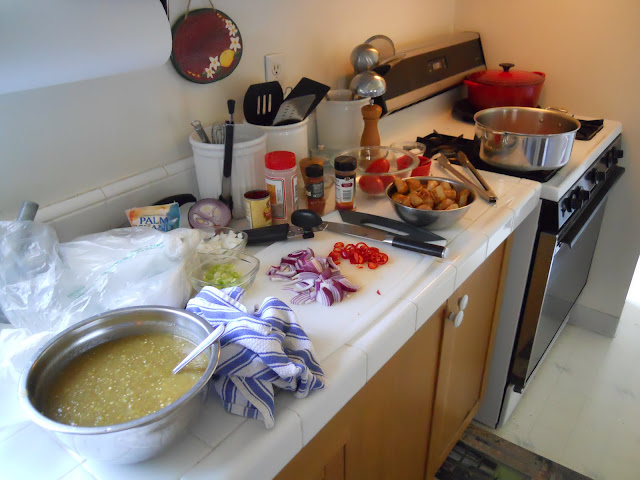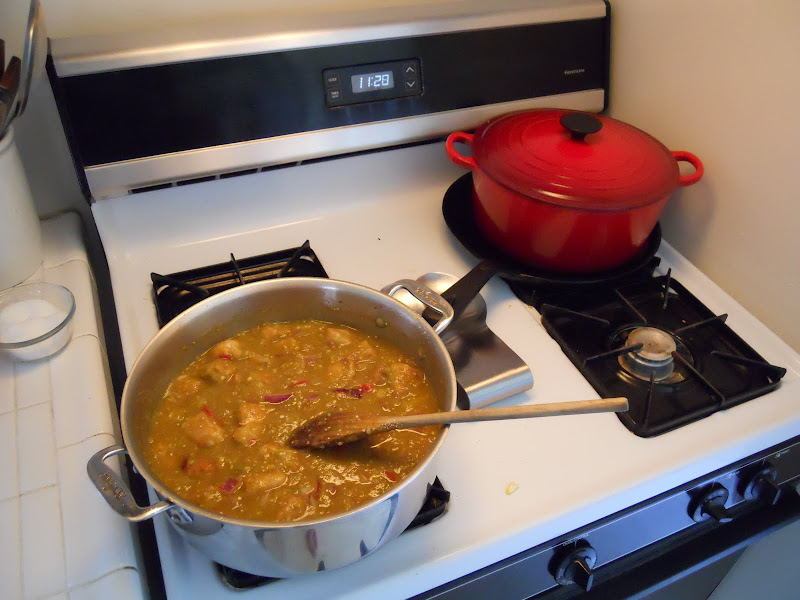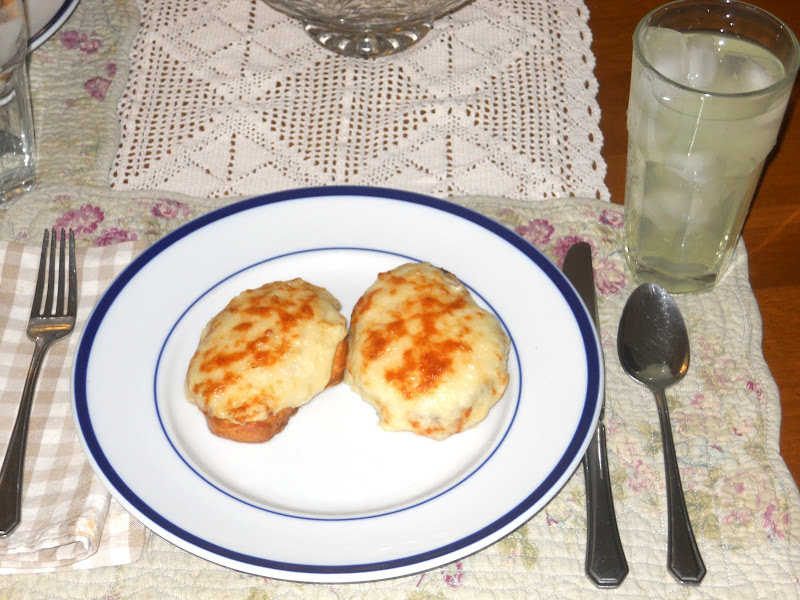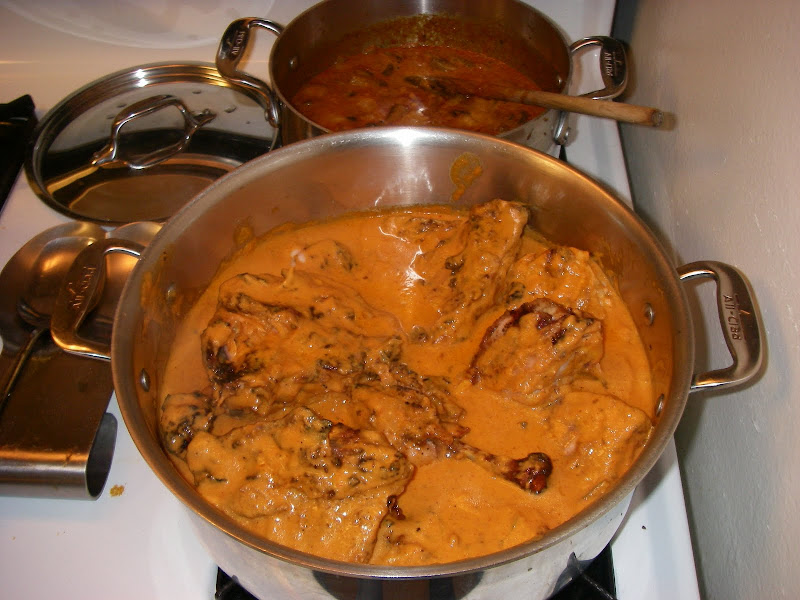Ingredients: (amounts for 10 quart yield - scale as necessary)
Pork (butt/shoulder) 8-10 lbs (weight without bones)
Tomatillo 20-25 medium
Jalapeno chili 30-40
Poblano chili 5
Hatch chili 30-40 (Anaheim can be substituted for Hatch, but it won't be as good or as spicy)
Serano chili 10-15
Cilantro 3 medium bunches
Onions 2 large white and one large sweet yellow (Maui/Oso/Vidalia)
Garlic 1 large head
Stock 2 - 4 quarts chicken stock
Maseca about 1/3 to 1/2 cup
Lard/bacon grease as needed for browning the pork
Chili powder 1-2 tablespoons
Black pepper 1-2 tablespoons
Marjoram 2-3 teaspoons
Mexican oregano 1-3 teaspoons
Cumin 1-2 teaspoon
Kosher salt to taste
Apple cider vinegar 1/2 cup + extra as required
Butter and flour Equal parts as needed to make a roux
Preparation:
Bone the pork butt/shoulder and cut into cubes. Meat should be cubed in 1/2" to 2" pieces, as desired. You need to adjust the size to your expected cooking time and the desired final consistency.
Thoroughly salt and season the meat with chili powder, pepper, marjoram, oregano and cumin. Splash the meat cubes with about 1/2 cup of cider vinegar and toss to mix and completely coat. Let the meat marinate for 1-4 hours.
Roast the chilies and tomatillos over an open flame or on a charcoal grill. The skin should be charred black and the chili softened. Remove from heat and place in a plastic bag. When the chilies have cooled peel off the charred skin. The tomatillos should be roasted until soft all over.
Puree and reserve the tomatillos.
Seed the chilies and puree in a blender with salt and stock and reserve. I prefer to use chicken stock, as it is somewhat neutral in flavor. Beef stock can be mixed in to give a richer flavor.
Puree the cilantro with some stock and reserve.
Roughly chop the white onions, puree with some stock and reserve.
Dredge the pork with enough Maseca to lightly cover all the cubes.
Heat lard or bacon grease in a heavy-bottomed pot (an enameled cast iron Dutch oven or a stock pot with a very thick base works best). I like the flavor imparted from the bacon grease, but I only use the fat from lightly smoked bacon. If you don't want any of the rich, smokey flavor, use lard. When the fat is hot add the pork cubes in small batches. You want to brown all sides of the pork cubes. Too much pork in the pan will lower the temperature and the meat will boil, not sear. Reserve the browned pork cubes in a bowl.
Dice the yellow onion and add to the pot. More lard/drippings might be needed to saute the onion. Stir frequently until the onion starts to get some color. Add the onion puree to the pot and deglaze the bottom. When the onion puree starts to darken add the garlic puree. Stir the onion-garlic puree frequently to prevent it from burning. Stir in the chili and cilantro purees.
Add the meat cubes to the pot. Stir to thoroughly coat all the meat. Add stock to achieve the desired volume. The Maseca used to dredge the meat will thicken the sauce somewhat. For more thickening you can add a roux to get the desired consistency. Roux is equal measures of fat (butter) and flour whisked over medium-high heat until the raw flavor is cooked out of the flour. You can make anything from a blonde roux to one that is nearly brick red. Just remember that the longer the roux cooks the less thickening power it has. A light blonde roux is probably best for this application. You can add the roux directly to the pot, but you will have to really whisk it well to prevent clumps. It is easier to add stock to the roux to thin it somewhat before adding to the chili. If you don't want to use a roux you need to limit the amount of stock added. Only use enough stock to keep the meat covered for duration of the cooking time. It is better to add more stock occasionally while cooking than to add too much.
Taste and adjust for seasoning and salt. I add some cumin, oregano and marjoram at this point. You want to just get hints of smokiness from the cumin and the herbaceousness from the marjoram and oregano. Add fresh ground black pepper and salt to taste
Once the chili comes to a simmer, add the tomatillo puree. As the tomatillo is very acidic, I add it in small batches, mix well and then taste. You just want to get to the point where the acidity balances the fats. As the chili simmers for hours, more fat and connective tissue will render out. It might be necessary to adjust for acidity at the end of the cooking time. Adding small splashes of cider vinegar will let you bring up the brightness.
It will take a minimum of four hours simmering over a low flame to get the pork to the desired tenderness. Cooking time will depend on the size of the pork cubes. You have to stir the chili regularly, scraping the bottom as you do. The more roux in the mix, the more easily it will scorch and stick to the bottom of the pot. If it scorches it will cause the chili to be bitter. Stir regularly and use a flame tamer if you have one. Some of you might have noticed that I had a heavy cast iron skillet between the burner and the pot of chili. That probably works better than a flame tamer anyway. Keep an eye on you chili to avoid any disasters.
Notes:
There are two components that will affect the final consistency of your chili; the meat and the sauce. The tenderness and mouth feel of the meat will depend on cooking time. Small cubes will cook faster, larger cubes, slower. As it cooks, the meat will go through several phases. After the initial sear it will be soft but chewy. As it simmers it will tighten up and get almost hard. After several hours of simmering it will start to break down and get tender. This is the sweet spot. You want soft, unctuous chunks of meat that still have a little bite. With continued simmering the meat will break down further into smaller pieces. While this is very good in chilaquiles, it is not ideal for chili. The thickness of the sauce will depend on the volume of cooking liquid used, how much it reduces and amount of thickening agent. A roux can be used to thicken the sauce. More roux makes a thicker, heavier sauce. If you do not want to use as much roux you can reduce the cooking liquid longer. You will get a more intense meat/chili flavor, but the sauce will not be as thick. To get a really thick, intense sauce without a roux you might need to reduce the sauce for 8-12 hours. If you are going to reduce the sauce for that long you should not put the meat in the pot for the first several hours, otherwise it will break down too much.
Serving suggestions:
I always like a little finely-shredded, sharp cheddar cheese on my chili. A little cotija sprinkled over the top is also good. If you want a creamier taste and not so much heat you can add a dollop of sour cream. You can eat the chili on its own or over tortilla chips. For a twist on the San Francisco classic, you can serve the chili in a hollowed-out sourdough boule.
| From The Hollow Leg Diner - images |
That ain't nothin' but good right there.
Chili verde prep
 |
| From The Hollow Leg Diner - images |
 |
| From The Hollow Leg Diner - images |
 |
| From The Hollow Leg Diner - images |
Sorry for the overly wordy post. I could never write a cookbook. If you have any questions, just submit a comment or send me a message. Thanks to all who participated in the chili cook-off.
I would be remiss if I didn't add a video from the reunion.
Tenors kickin' ass and takin' names.









